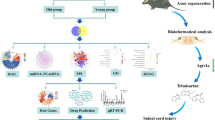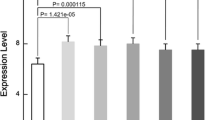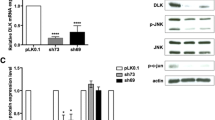Abstract
In the adult central nervous system (CNS), axon regeneration is a major hurdle for functional recovery after trauma. The intrinsic growth potential of an injured axon varies widely between neurons. The underlying molecular mechanisms of such heterogeneity are largely unclear. In the present study, the adult zebrafish dataset GSE56842 were downloaded. Differentially expressed genes (DEGs) were sorted and deeply analyzed by bioinformatics methods. Gene Ontology (GO) and Kyoto Encyclopedia of Genes and Genomes (KEGG) pathway enrichment analysis of DEGs were performed with the DAVID. A DEGs-associated protein–protein interaction network was constructed from the STRING database and visualized with Cytoscape software. In total, 621 DEGs were identified. GO analysis showed that the biological processes of DEGs focused mainly on the Notch signaling pathway, cell differentiation and positive regulation of neuron differentiation. The molecular functions mainly included calcium-transporting ATPase activity and calcium ion binding and structural constituents of the cytoskeleton. The cellular components included the plasma membrane, spectrin, and cytoplasmic and membrane-bound vesicles. KEGG pathway analysis showed that these DEGs were mainly involved in the metabolic pathway and Notch signaling pathway, and subnetworks revealed that genes within modules were involved in the metabolic pathway, Wnt signaling pathway, and calcium signaling pathway. This study identified DEG candidate genes and pathways involved in the heterogeneity of the intrinsic growth ability between neurons after spinal cord injury in adult zebrafish, which could facilitate our understanding of the molecular mechanisms underlying axon regeneration, and these candidate genes and pathways could be therapeutic targets for the treatment of CNS injury.





Similar content being viewed by others
References
Schwab ME (2002) Repairing the injured spinal cord. Science (New York, NY) 295(5557):1029–1031. https://doi.org/10.1126/science.1067840
Assinck P, Duncan GJ, Hilton BJ, Plemel JR, Tetzlaff W (2017) Cell transplantation therapy for spinal cord injury. Nat Neurosci 20(5):637–647. https://doi.org/10.1038/nn.4541
David S, Lacroix S (2003) Molecular approaches to spinal cord repair. Annu Rev Neurosci 26:411–440. https://doi.org/10.1146/annurev.neuro.26.043002.094946
Silva NA, Sousa N, Reis RL, Salgado AJ (2014) From basics to clinical: a comprehensive review on spinal cord injury. Progr Neurobiol 114:25–57. https://doi.org/10.1016/j.pneurobio.2013.11.002
Bunge MB (2016) Efficacy of Schwann cell transplantation for spinal cord repair is improved with combinatorial strategies. J Physiol 594(13):3533–3538. https://doi.org/10.1113/jp271531
Blesch A, Tuszynski MH (2009) Spinal cord injury: plasticity, regeneration and the challenge of translational drug development. Trends Neurosci 32(1):41–47. https://doi.org/10.1016/j.tins.2008.09.008
Tuszynski MH, Steward O (2012) Concepts and methods for the study of axonal regeneration in the CNS. Neuron 74(5):777–791. https://doi.org/10.1016/j.neuron.2012.05.006
van Niekerk EA, Tuszynski MH, Lu P, Dulin JN (2016) Molecular and cellular mechanisms of axonal regeneration after spinal cord injury. Mol Cell Proteom. 15(2):394–408. https://doi.org/10.1074/mcp.R115.053751
Lu Y, Belin S, He Z (2014) Signaling regulations of neuronal regenerative ability. Curr Opin Neurobiol 27:135–142. https://doi.org/10.1016/j.conb.2014.03.007
Scheib J, Hoke A (2013) Advances in peripheral nerve regeneration. Nat Rev Neurol 9(12):668–676. https://doi.org/10.1038/nrneurol.2013.227
Kogenaru S, Qing Y, Guo Y, Wang N (2012) RNA-seq and microarray complement each other in transcriptome profiling. BMC Genom 13:629. https://doi.org/10.1186/1471-2164-13-629
Vogelstein B, Papadopoulos N, Velculescu VE, Zhou S, Diaz LA Jr, Kinzler KW (2013) Cancer genome landscapes. Science (New York, NY) 339(6127):1546–1558. https://doi.org/10.1126/science.1235122
Dennis G Jr, Sherman BT, Hosack DA, Yang J, Gao W, Lane HC, Lempicki RA (2003) DAVID: Database for annotation, visualization, and integrated discovery. Genome Biol 4(5):P3
Kadoya K, Lu P, Nguyen K, Lee-Kubli C, Kumamaru H, Yao L, Knackert J, Poplawski G, Dulin JN, Strobl H, Takashima Y, Biane J, Conner J, Zhang SC, Tuszynski MH (2016) Spinal cord reconstitution with homologous neural grafts enables robust corticospinal regeneration. Nat Med 22(5):479–487. https://doi.org/10.1038/nm.4066
Liu K, Tedeschi A, Park KK, He Z (2011) Neuronal intrinsic mechanisms of axon regeneration. Annu Rev Neurosci 34:131–152. https://doi.org/10.1146/annurev-neuro-061010-113723
Bray D (1989) Growth cone formation and navigation: axonal growth. Curr Opin Cell Biol 1(1):87–90
Ziv NE, Spira ME (1997) Localized and transient elevations of intracellular Ca2+ induce the dedifferentiation of axonal segments into growth cones. J Neurosci 17(10):3568–3579
Kamber D, Erez H, Spira ME (2009) Local calcium-dependent mechanisms determine whether a cut axonal end assembles a retarded endbulb or competent growth cone. Exp Neurol 219(1):112–125. https://doi.org/10.1016/j.expneurol.2009.05.004
Mar FM, Bonni A, Sousa MM (2014) Cell intrinsic control of axon regeneration. EMBO Rep 15(3):254–263. https://doi.org/10.1002/embr.201337723
Mandolesi G, Madeddu F, Bozzi Y, Maffei L, Ratto GM (2004) Acute physiological response of mammalian central neurons to axotomy: ionic regulation and electrical activity. FASEB J 18(15):1934–1936. https://doi.org/10.1096/fj.04-1805fje
Ghosh-Roy A, Wu Z, Goncharov A, Jin Y, Chisholm AD (2010) Calcium and cyclic AMP promote axonal regeneration in Caenorhabditis elegans and require DLK-1 kinase. J Neurosci 30(9):3175–3183. https://doi.org/10.1523/jneurosci.5464-09.2010
Zundorf G, Reiser G (2011) Calcium dysregulation and homeostasis of neural calcium in the molecular mechanisms of neurodegenerative diseases provide multiple targets for neuroprotection. Antioxid Redox Signal 14(7):1275–1288. https://doi.org/10.1089/ars.2010.3359
He Z, Jin Y (2016) Intrinsic control of axon regeneration. Neuron 90(3):437–451. https://doi.org/10.1016/j.neuron.2016.04.022
Plunet W, Kwon BK, Tetzlaff W (2002) Promoting axonal regeneration in the central nervous system by enhancing the cell body response to axotomy. J Neurosci Res 68(1):1–6. https://doi.org/10.1002/jnr.10176
Belin S, Nawabi H, Wang C, Tang S, Latremoliere A, Warren P, Schorle H, Uncu C, Woolf CJ, He Z, Steen JA (2015) Injury-induced decline of intrinsic regenerative ability revealed by quantitative proteomics. Neuron 86(4):1000–1014. https://doi.org/10.1016/j.neuron.2015.03.060
Liu K, Lu Y, Lee JK, Samara R, Willenberg R, Sears-Kraxberger I, Tedeschi A, Park KK, Jin D, Cai B, Xu B, Connolly L, Steward O, Zheng B, He Z (2010) PTEN deletion enhances the regenerative ability of adult corticospinal neurons. Nat Neurosci 13(9):1075–1081. https://doi.org/10.1038/nn.2603
Sun F, Park KK, Belin S, Wang D, Lu T, Chen G, Zhang K, Yeung C, Feng G, Yankner BA, He Z (2011) Sustained axon regeneration induced by co-deletion of PTEN and SOCS3. Nature 480(7377):372–375. https://doi.org/10.1038/nature10594
Rossi F, Gianola S, Corvetti L (2007) Regulation of intrinsic neuronal properties for axon growth and regeneration. Progr Neurobiol 81(1):1–28. https://doi.org/10.1016/j.pneurobio.2006.12.001
Yiu G, He Z (2006) Glial inhibition of CNS axon regeneration. Nat Rev Neurosci 7(8):617–627. https://doi.org/10.1038/nrn1956
Po MD, Calarco JA, Zhen M (2012) Releasing the inner inhibition for axon regeneration. Neuron 73(2):207–209. https://doi.org/10.1016/j.neuron.2012.01.002
Garcia AL, Udeh A, Kalahasty K, Hackam AS (2018) A growing field: the regulation of axonal regeneration by Wnt signaling. Neural Regenen Res 13(1):43–52. https://doi.org/10.4103/1673-5374.224359
El Bejjani R, Hammarlund M (2012) Notch signaling inhibits axon regeneration. Neuron 73(2):268–278. https://doi.org/10.1016/j.neuron.2011.11.017
Patel AK, Park KK, Hackam AS (2017) Wnt signaling promotes axonal regeneration following optic nerve injury in the mouse. Neuroscience 343:372–383. https://doi.org/10.1016/j.neuroscience.2016.12.020
Strand NS, Hoi KK, Phan TMT, Ray CA, Berndt JD, Moon RT (2016) Wnt/beta-catenin signaling promotes regeneration after adult zebrafish spinal cord injury. Biochem Biophys Res Commun 477(4):952–956. https://doi.org/10.1016/j.bbrc.2016.07.006
Yang P, Yang Z (2012) Enhancing intrinsic growth capacity promotes adult CNS regeneration. J Neurol Sci 312(1–2):1–6. https://doi.org/10.1016/j.jns.2011.08.037
Ueda Y, Shimizu Y, Shimizu N, Ishitani T, Ohshima T (2018) Involvement of sonic hedgehog and notch signaling in regenerative neurogenesis in adult zebrafish optic tectum after stab injury. J Comp Neurol 526(15):2360–2372. https://doi.org/10.1002/cne.24489
Hivert B, Liu Z, Chuang CY, Doherty P, Sundaresan V (2002) Robo1 and Robo2 are homophilic binding molecules that promote axonal growth. Mol Cell Neurosci 21(4):534–545
Gorsuch RA, Lahne M, Yarka CE, Petravick ME, Li J, Hyde DR (2017) Sox2 regulates Muller glia reprogramming and proliferation in the regenerating zebrafish retina via Lin28 and Ascl1a. Exp Eye Res 161:174–192. https://doi.org/10.1016/j.exer.2017.05.012
Tsuruma K, Saito Y, Okuyoshi H, Yamaguchi A, Shimazawa M, Goldman D, Hara H (2018) Granulin 1 promotes retinal regeneration in zebrafish. Investig Ophthalmol Vis Sci 59(15):6057–6066. https://doi.org/10.1167/iovs.18-24828
Acknowledgements
This work is Supported by National Natural Foundation of China (No. 81520108017).
Author information
Authors and Affiliations
Corresponding authors
Ethics declarations
Conflict of interest
The authors declare no conflict of interest.
Additional information
Publisher's Note
Springer Nature remains neutral with regard to jurisdictional claims in published maps and institutional affiliations.
Rights and permissions
About this article
Cite this article
Fu, H., Han, G., Li, H. et al. Identification of Key Genes and Pathways Involved in the Heterogeneity of Intrinsic Growth Ability Between Neurons After Spinal Cord Injury in Adult Zebrafish. Neurochem Res 44, 2057–2067 (2019). https://doi.org/10.1007/s11064-019-02841-1
Received:
Revised:
Accepted:
Published:
Issue Date:
DOI: https://doi.org/10.1007/s11064-019-02841-1




